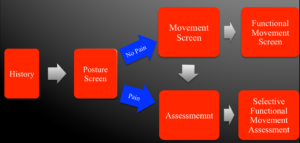By Mitch Hauschildt, MA, ATC, CSCS
What is the most important thing when designing a program? Is it exercise selection? Is it the sequencing and timing of your interventions? Is it sets, reps, and volume?
Those things are all important, but the honest truth is that the most important thing in the programming process is the evaluation. This is true in therapy, strength and conditioning, fitness or any other process to improve performance, movement quality or pain.
Unfortunately, a lot of people skim over the evaluation process, assuming that they just “know” their patients based on past experiences, visual cues or a subjective explanation of their goals or problems. Or, they either don’t know how to perform a really good evaluation. And, unfortunately, many people are equipped to perform a good evaluation, but they just don’t take the time to do it.
The intriguing thing is that in a country where the almighty dollar drives of lot of our healthcare choices, it is interesting that every year we spend almost twice as much money on treating musculoskeletal injuries as heart conditions, but we don’t have nearly the same “gold standard” evaluation processes in place for musculoskeletal pain as we do heart issues. My opinion is that needs to change.
If we don’t know our patients (or clients) we can’t adequately program for them.
Without a good evaluation, programming is really just throwing darts at a dart board. It’s literally a stab in the dark, hoping to find something that sticks. Then we scratch our head and wonder why our interventions don’t work.
When you consider your evaluation, it is important that you systematize the process. This is to ensure that you don’t miss anything with any of your patients or clients. Without a standard process, it is easy to jump from one thing to another and miss something in between. By using or creating a standardized process for every person (regardless of injury or level of activity), you not only cover all of your bases, but you get really good at it and improve your efficiency. That way your evaluation process doesn’t feel so consuming.
Further, in a results oriented society, it is important that we have a number of different things that we can point to in order to prove our worth. I certainly won’t tell you to stack the deck to make sure you as a professional look really good, but it is also important that you have some things to hang your hat on in case things outside of your control affect your patient or client outcomes. With a good evaluation, it gives you things to point to that show improvement other than pain or a specific number to show why they need to continue to work hard and stay in your program.
What system you use isn’t nearly as important has having a system in place.
Even though I use a lot of bits and pieces from a lot of different processes and programs that are available, if I had to be defined by a single evaluation process, most people would call me a FMS/SFMA guy.
I utilize the Functional Movement Screen (FMS) for our non painful and “healthy” athletes to help us identify injury risk and motor pattern dysfunction. The FMS isn’t perfect and from time to time, I find myself hoping some things will be improved with it, but overall it’s as good or better than anything else out there right now and it ensures that I have looked at every area of the body within my single evaluation process.
Critics of the FMS often cite lack of time or resources to be able to implement the FMS and subsequent correctives into their training programs. While I understand that it does take time, effort and resources, those pale in comparison to athletes missing training sessions due to an ACL tear or other major injury. Also, an athlete who performs well in the FMS tends to perform well in their activity, so try telling your coach, athlete, patient, or client that you don’t have time to make them better. It is our job.
As good as the FMS is, it isn’t designed for painful patients or those with an injury. This is where the Selective Functional Movement Assessment (SFMA) comes into play. It is much more detailed and specific and works very well with identifying dysfunction with patients who are in pain or have had an injury. Those patients need to be analyzed in greater detail than those who aren’t in pain.
The reason I believe heavily in both of these evaluation processes is because both of them look at the entire body in an efficient, systematic way. They ensure that I don’t miss an ankle issue when I’m working on my shoulder patient. They make sure that I find a potentially problematic shoulder mobility problem in a client who is trying to lose weight. And, they make sure that my post operative knee patient has decent rotational stability prior to training for their next obstacle course race.
Treatment is simple…Find dysfunction and Fix it.
The reason a good evaluation is important is because making athletes run faster, helping people avoid injury and getting people out of pain are almost always simple when it comes down to it…find their dysfunction and fix it. That’s why I fix an ankle mobility issue when I find it, regardless of whether I can prove that it is related to the primary complaint. Because, while I can’t prove that it is causing the issue, I also can’t prove that it isn’t causing it. 
The theoretical construct of the evaluation process that we discuss in Neurofacilitation for Better Movement is that we always start with taking a history of complaints or issues. From there, we look at a static postural screen so that we can see some of their dysfunction while they stand (or sit) in front of you. Oftentimes this will show you a lack of joint centration in specific joints.
From there, if they are in pain, you go to the SFMA and treat the results of the assessment. If they aren’t in pain, go to the FMS to see how well they move and make interventions as needed. If you find pain during the FMS, you go directly to the SFMA to nail down the cause of the pain.
Of course make sure that you stay within your skill set and scope of practice and refer to your team of professionals as needed. But, without a good evaluation, you won’t be able to adequately serve your athletes, patients or clients. Feel free to develop your own or use one of the high quality options that are on the market. Just make sure you are using a high quality, total body, systematic evaluation process.



Leave a Reply